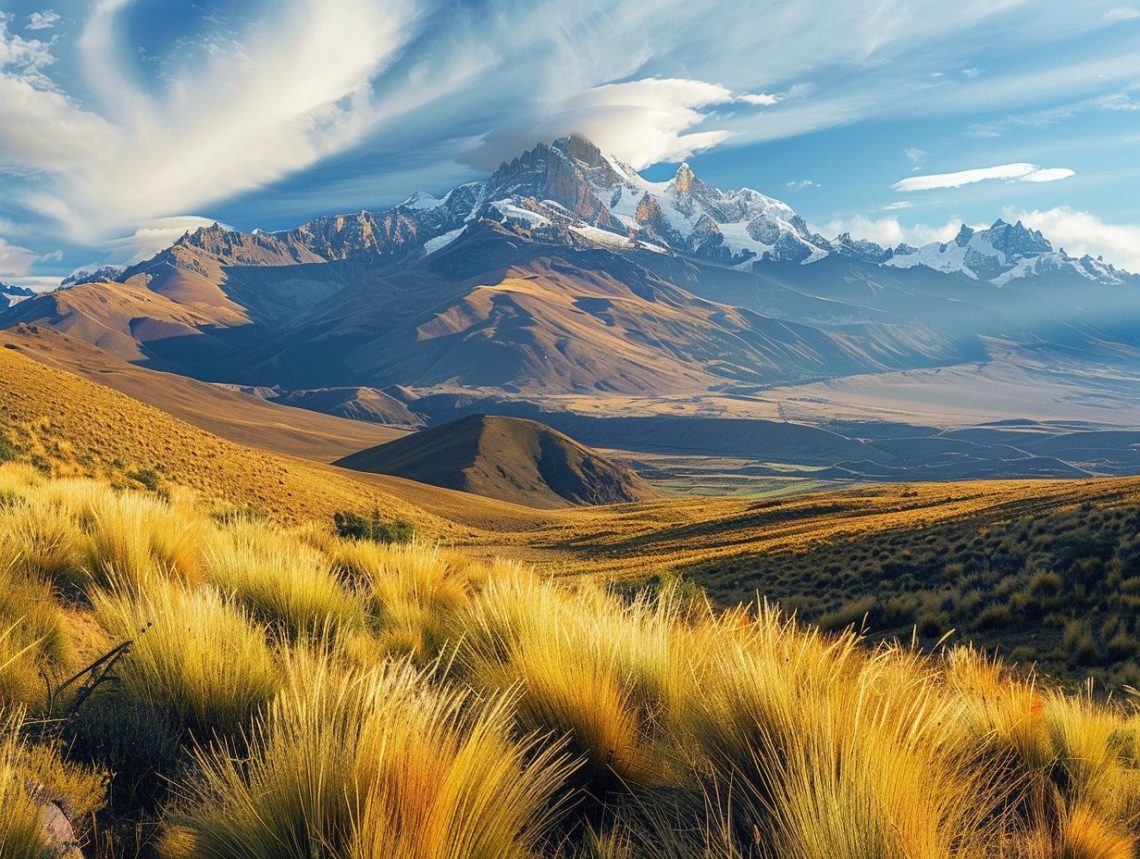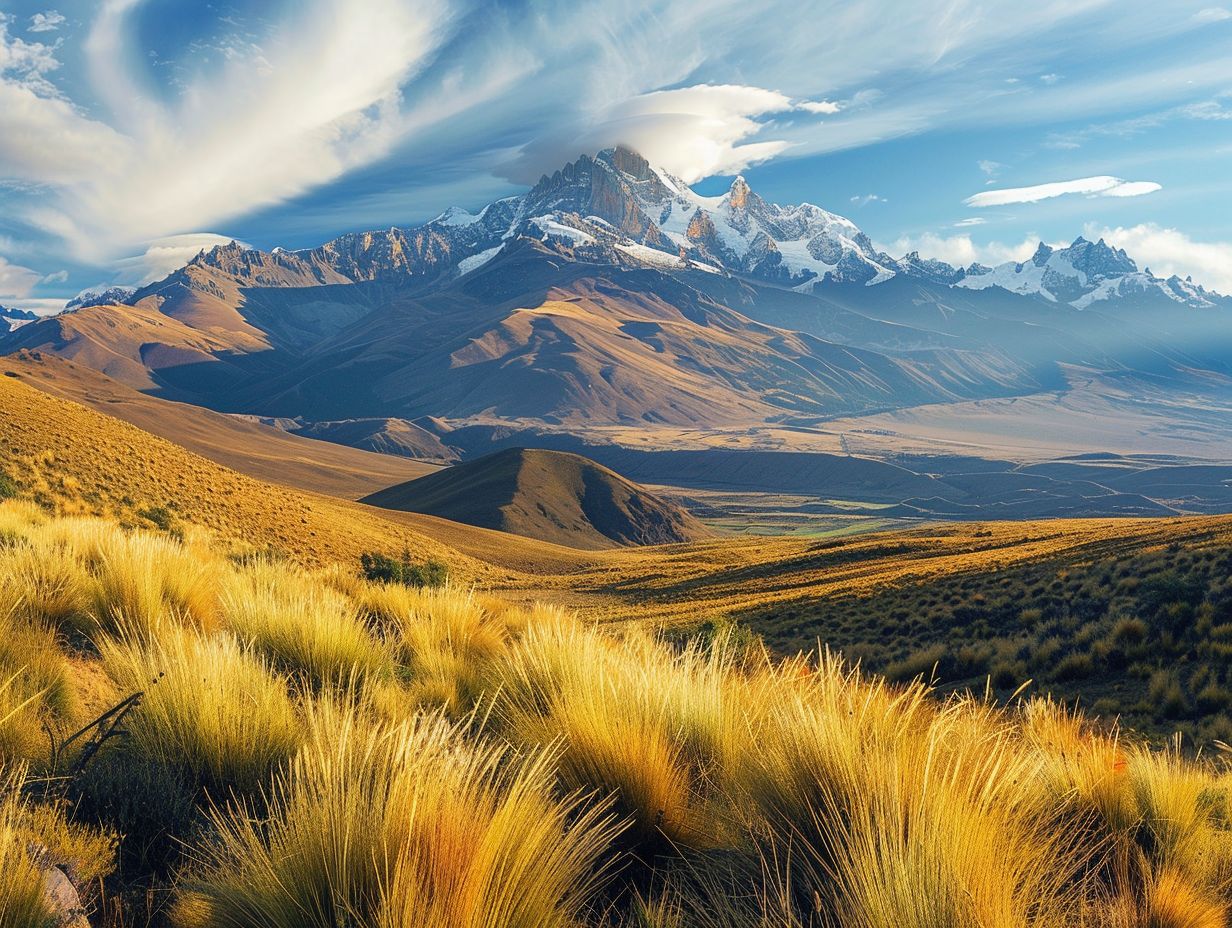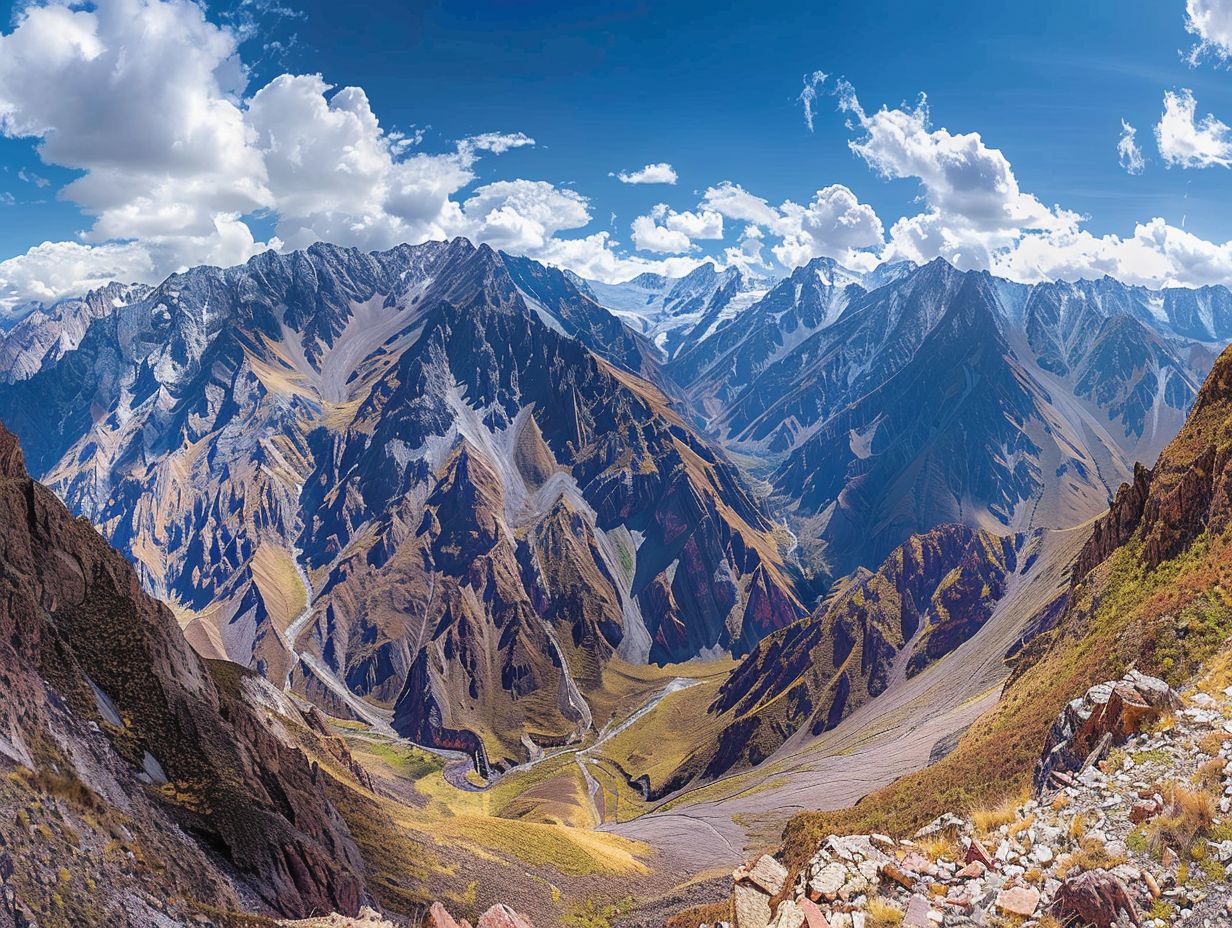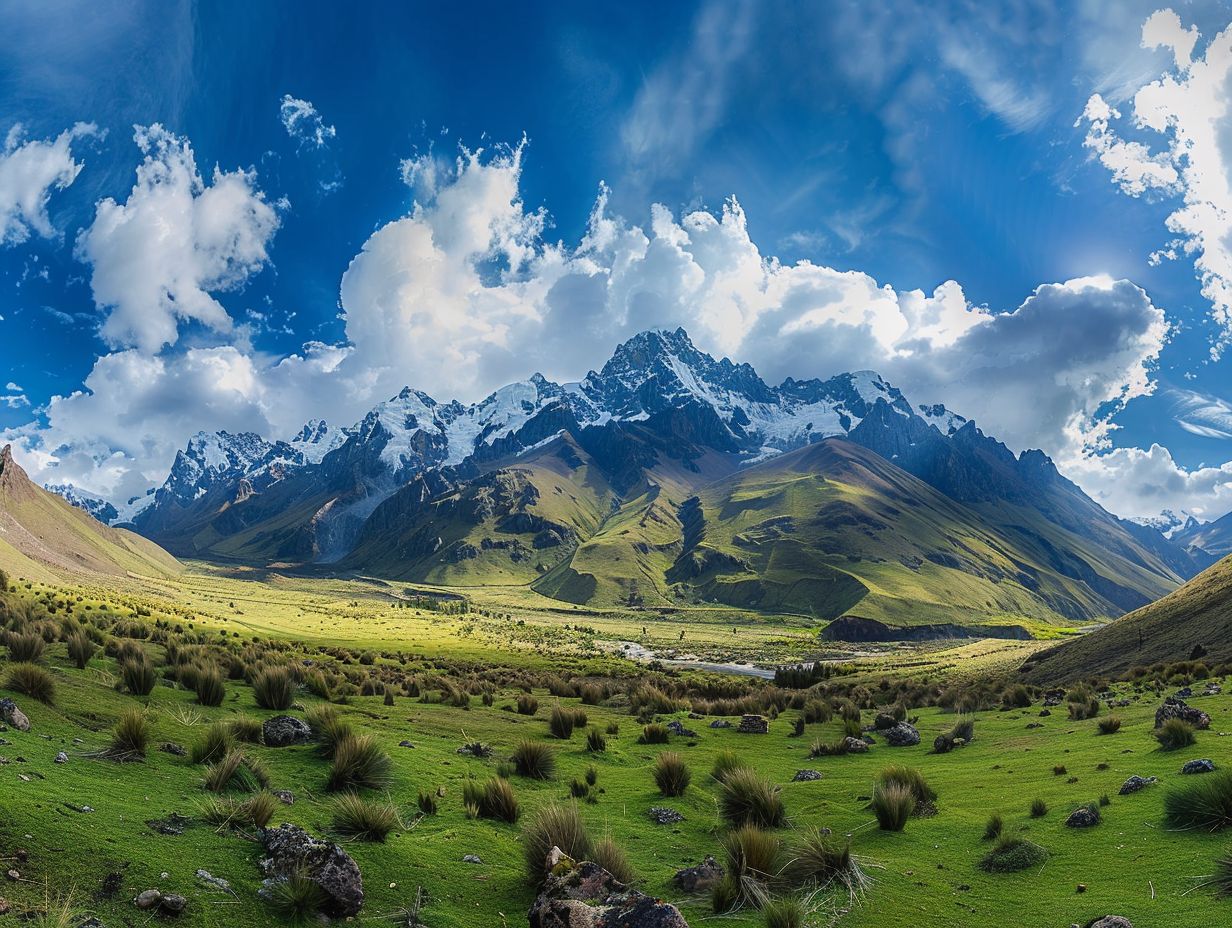
Tallest Mountains In South America
The Andes, a majestic mountain range that stretches across South America, is home to some of the tallest peaks on the continent.
From the towering Aconcagua to the rugged Ojos del Salado, these mountains command respect and admiration.
Discover how these giants were formed, their role in the ecosystem and climate of South America, and the challenges climbers face when attempting to conquer these peaks.
Join us as we explore the wonders and dangers of the Andes.
Key Takeaways:

- The Andes is the dominant mountain range in South America, spanning through multiple countries.
- The tallest mountains in South America include Aconcagua, Ojos del Salado, Monte Pissis, Huascarán, and Yerupajá.
- These mountains play a crucial role in the ecosystem and climate of South America, but climbing them poses significant challenges and safety risks.
The Andes: A Mountain Range Dominating South America
The Andes mountain range, dominating the South American continent, is a majestic natural wonder that spans several countries and serves as a significant geographical feature.
Stretching over 7,000 kilometers along the western coast of South America, the Andes are the world’s longest continental mountain range.
Its vast expanse includes numerous peaks exceeding 6,000 meters in altitude, with Mount Aconcagua standing as the highest summit in the Western Hemisphere.
The region’s unique topography has fostered exceptional biodiversity, providing a habitat for countless plant and animal species found nowhere else on Earth.
The Andes have not only shaped the physical landscape but also influenced the cultural and historical development of the surrounding civilizations for millennia.
What Countries are Part of the Andes?
The Andes mountain range stretches across several South American countries, including Argentina, Chile, Peru, Bolivia, Ecuador, and Colombia.
Each of these countries contributes to the diversity and beauty of the Andes range.
- Argentina boasts the majestic Aconcagua, the highest peak in the Western Hemisphere, standing at an impressive 6,960 meters above sea level.
- Chile is home to the breathtaking Torres del Paine National Park, showcasing stunning granite peaks and pristine glaciers.
- Peru houses the iconic Machu Picchu, nestled amidst the Andean mountains and a UNESCO World Heritage site.
- Bolivia’s Sajama is known for its volcanic peak, providing dramatic landscapes and unique trekking opportunities.
The Tallest Mountains in South America
Among the tallest mountains in South America stand majestic peaks that challenge climbers and captivate adventurers with their awe-inspiring heights and rugged beauty.
1. Aconcagua
Aconcagua, the highest peak in South America located in Argentina, lures climbers from around the world to test their skills and endurance on its challenging slopes.
Aconcagua reaches an impressive altitude of approximately 22,841 feet above sea level, making it a formidable challenge for even the most seasoned climbers.
The mountain offers various climbing routes, with the Normal Route being the most popular due to its accessibility and relative ease compared to other routes.
Notable expeditions to Aconcagua include the 1897 expedition led by Matthias Zurbriggen, who made the first recorded ascent of the peak.
The mountain holds historical significance as it has been a testing ground for mountaineers seeking to push their limits in high-altitude environments.
2. Ojos del Salado
Ojos del Salado, situated in Chile, is one of the notable peaks in South America, attracting climbers seeking to conquer its challenging terrain.
Standing at an impressive 22,615 feet above sea level, Ojos del Salado is the highest volcano in the world and the second-highest peak in the Western Hemisphere.
It’s location in the Andes mountain range offers climbers a unique combination of desert landscapes, snow-capped peaks, and breathtaking views of the surrounding terrain.
With a variety of climbing routes catering to both experienced mountaineers and adventurous beginners, Ojos del Salado presents a range of challenges.
3. Monte Pissis

Monte Pissis in Argentina offers a formidable challenge to climbers aiming to reach its summit, blending breathtaking views with technical climbing requirements.
The allure of Monte Pissis lies not only in its impressive altitude of over 22,000 feet but also in the captivating lunar-like landscape that unfolds as climbers ascend.
The region surrounding this volcanic peak features vast stretches of rugged terrain, dotted with crater lakes and ice fields, adding a surreal touch to the climb.
The difficulties faced by mountaineers tackling Monte Pissis include unpredictable weather patterns, severe altitude sickness, and technical demands.
Each step towards the summit is a test of endurance and skill. The historical significance of this mountain cannot be overlooked.
Named after the Italian geologist Augusto and Pedro José Amadeo Pissis, Monte Pissis serves as a reminder of the exploration and scientific endeavors.
4. Huascarán
Huascarán in Peru stands as a prominent peak in South America, beckoning climbers to conquer its challenging routes and reach the pinnacle of its majestic summit.
Nestled in the Cordillera Blanca range, Huascarán attracts experienced mountaineers seeking the ultimate test of skill and endurance.
The mountain’s diverse terrain presents a myriad of obstacles, from steep ice slopes to unpredictable weather conditions.
As climbers ascend its icy slopes, they are met with breathtaking views of surrounding peaks and valleys, showcasing the raw beauty of the Andean landscape.
The sheer magnitude of Huascarán’s presence commands respect, drawing individuals from around the world to test their limits and experience exhilaration.
5. Yerupajá
Yerupajá in Peru presents a formidable challenge to mountaineers seeking to test their skills and endurance on its treacherous slopes and reach its imposing summit.
Known as the second-highest peak in the Cordillera Huayhuash range, Yerupajá stands tall at 6,617 meters above sea level.
It’s sheer vertical walls, unpredictable weather conditions, and technical climbing routes make conquering this mountain a true test.
Yerupajá also holds historical significance, as it was first ascended in 1950 by renowned climbers Hermann Huber and Heinrich Harrer.
How Were These Mountains Formed?
The towering mountains of South America, including the Andes range, were sculpted over millennia by the relentless forces of tectonic plate movements.
These majestic peaks owe their formation to the convergence of the South American Plate and the Nazca Plate.
Continuous subduction of the denser oceanic crust beneath the lighter continental plate has led to creation of a breathtaking topography.
The collision and compression of these massive plates have resulted in the height of the Andes and triggered volcanic activity, further shaping the mountains.
What is the Geology of the Andes?
The Andes exhibit a complex geological history shaped by the collision of tectonic plates, volcanic activity, and the gradual uplift of ancient marine deposits.
These geological intricacies have been a subject of fascination for scientists and geologists for centuries.
The Andes showcase crustal transformation through millions of years, driven by Nazca plate subduction under South America, key in mountain formation.
This subduction zone has resulted in the formation of numerous volcanic complexes along the Andean range, giving rise to dramatic peaks and fertile valleys.
The Importance of These Mountains in South America
The mountains of South America play a vital role in shaping the continent’s ecosystems, fostering unique biodiversity, and influencing regional climate patterns.
With a diverse array of ecosystems found at varying elevations, the South American mountains provide habitats for numerous plant and animal species.
These mountain ranges act as biological corridors, allowing for the migration and dispersion of flora and fauna, thereby enhancing genetic diversity.
The towering peaks also impact local weather patterns, influencing rainfall distribution, temperature gradients, and even creating microclimates.
What Role Do These Mountains Play in the Ecosystem?

The mountains of South America support diverse ecosystems teeming with unique flora and fauna, contributing to the rich biodiversity of the region.
These mountain ranges are home to a fascinating array of plant and animal species, some of which are found nowhere else on Earth.
From the Andes in the west to the Pantanal in the east, these mountains provide important habitats for countless organisms.
The lush forests of the Amazon Basin are a treasure trove of biodiversity, hosting a vast variety of plant species, including towering tree ferns, orchids, and medicinal plants.
How Do These Mountains Affect the Climate in South America?
The towering mountains of South America significantly influence the regional climate patterns, creating diverse microclimates.
The Andes create a barrier, blocking moisture from the Pacific, leading to arid coastal climates and lush rainforests on the eastern slopes.
Areas like the Amazon basin experience high levels of rainfall due to orographic lifting, where moist air is forced to rise over the mountains and condense into precipitation.
Temperature varies significantly in the Andes, with cooler climates at higher altitudes, contrasting with the hot and humid conditions in the low-lying Amazon basin.
Challenges and Risks of Climbing These Mountains
Climbing the towering peaks of South America presents mountaineers with a host of challenges and risks, testing their skills, endurance, and resilience in extreme altitudes.
High-altitude climbers face not just extreme conditions but also altitude sickness, ranging from headaches to severe issues like HAPE and HACE.
These altitude-related risks can quickly escalate, making it crucial for climbers to acclimatize properly and recognize the early signs of altitude sickness.
What Are the Biggest Challenges Faced by Climbers?
Climbers tackling South America’s peaks encounter a myriad of challenges, including extreme altitudes, unpredictable weather, crevasses, and technical climbing requirements, necessitating meticulous planning and adherence to safety protocols.
One of the most daunting challenges faced by climbers in these mountains is altitude sickness, which can strike unexpectedly.
This condition, if not managed properly, can have severe consequences on physical and mental well-being, emphasizing the crucial role of expert climbing guides.
Along with altitude-related risks, climbers must also navigate through treacherous weather conditions, such as sudden storms, blizzards, and drastic temperature.
These hazards demand a high level of preparedness and the ability to make quick decisions to ensure the team’s survival.
Technical difficulties like steep icy slopes, shear rock faces, and challenging route finding present formidable obstacles that require specialized skills and equipment.
Climbers heavily rely on their guides’ expertise in rope handling, gear selection, and route planning to safely navigate through these perilous terrains.
What Are the Safety Risks Involved in Climbing These Mountains?

Ascending South America’s challenging peaks involves inherent safety risks, including altitude-related illnesses, oxygen deprivation, avalanches, and the potential for accidents resulting in casualties.
Mountaineers scaling these remote and rugged summits must be well-prepared and aware of the dangers that lurk at high altitudes.
Altitude sickness, frostbite, and hypothermia are common threats, exacerbated by unpredictable weather conditions and treacherous terrain.
Proper acclimatization, sturdy footwear, ice axes, and ropes are critical tools in a climber’s arsenal.
Carrying emergency supplies such as first aid kits, high-energy snacks, and communication devices can mean the difference between life and death in case of a mishap.
Frequently Asked Questions
1. What is the tallest mountain in South America?
A: The tallest mountain in South America is Mount Aconcagua, standing at 22,841 feet (6,962 meters) above sea level.
2. Where is Mount Aconcagua located?
A: Mount Aconcagua is located in the Andes mountain range, on the border between Argentina and Chile.
3. How long does it take to climb Mount Aconcagua?
A: The average time to climb Mount Aconcagua is 2-3 weeks, depending on the route chosen and the individual’s physical condition.
4. What is the difficulty level of climbing Mount Aconcagua?
A: Mount Aconcagua is considered a technically challenging climb, with steep slopes, high altitude, and extreme weather conditions.
5. Are there any other notable mountains in South America besides Mount Aconcagua?
A: Yes, other notable mountains in South America include Mount Ojos del Salado (22,615ft/6,893m), Nevado Huascarán (22,205ft/6,768m), and Chimborazo (20,564ft/6,263m).
6. Has anyone ever climbed all the tallest mountains in South America?
A: Yes, Patrick Morrow, an accomplished Canadian mountaineer, was the first person to summit all the tallest mountains in South America, also known as the “Seven Summits of South America.”